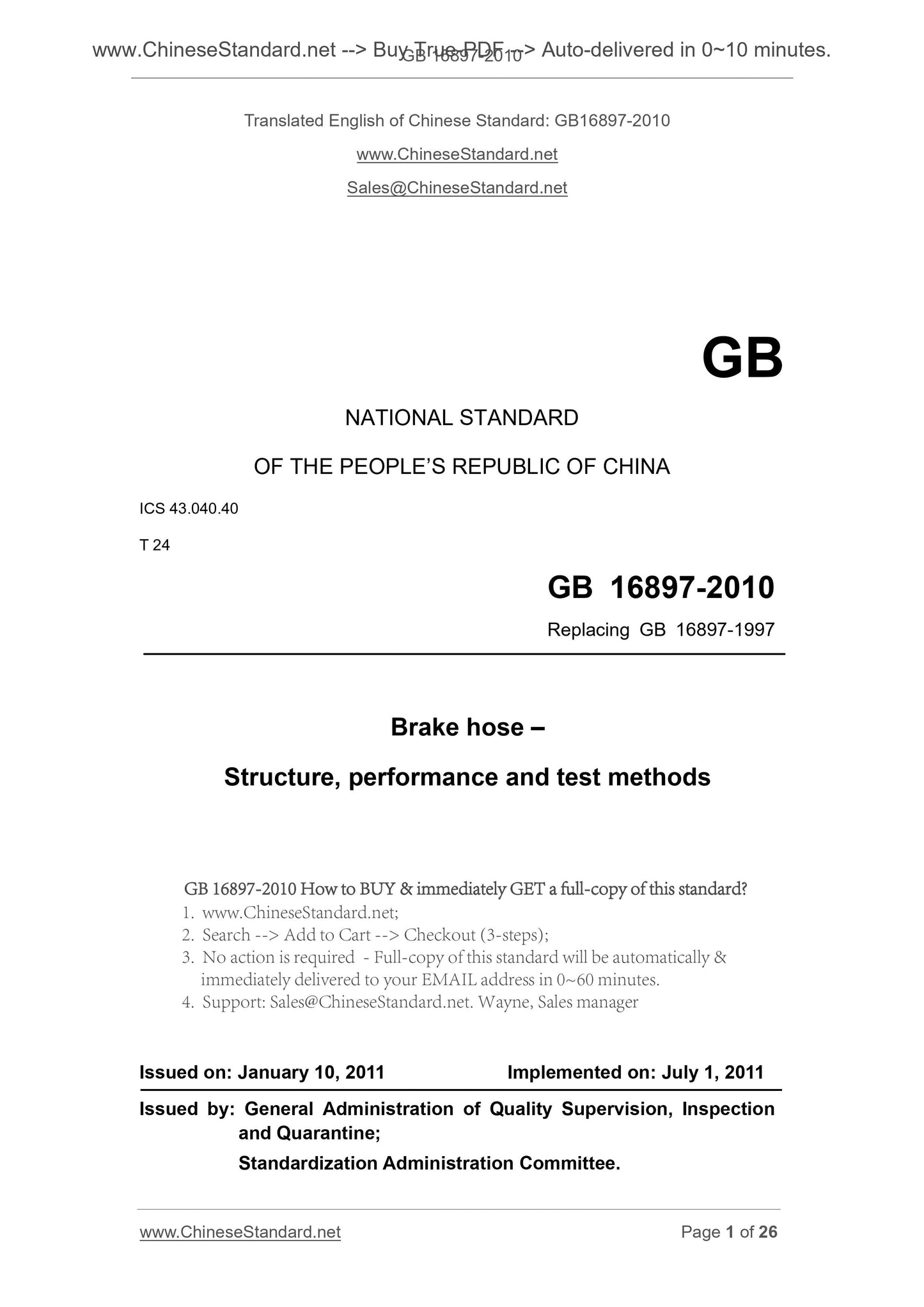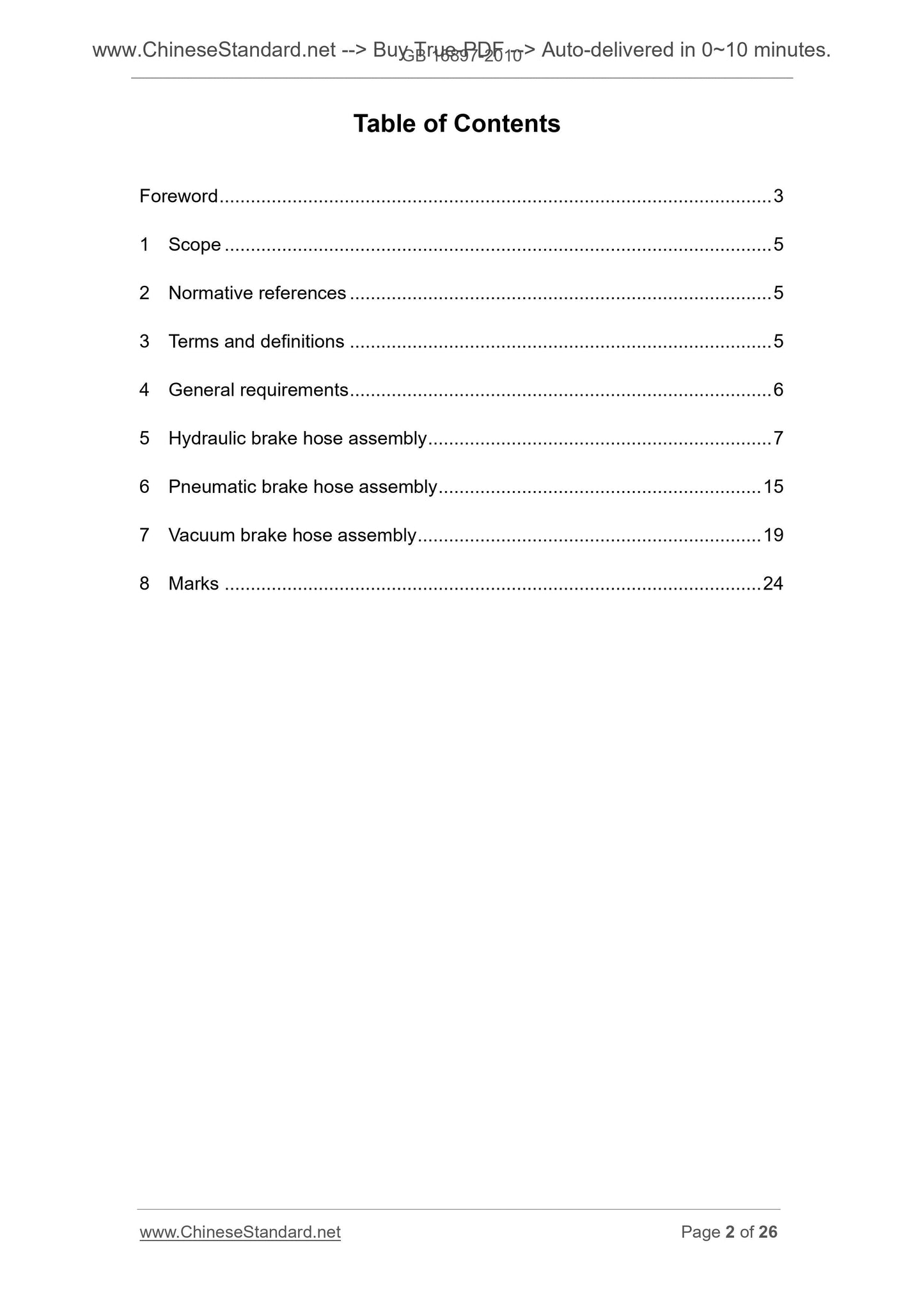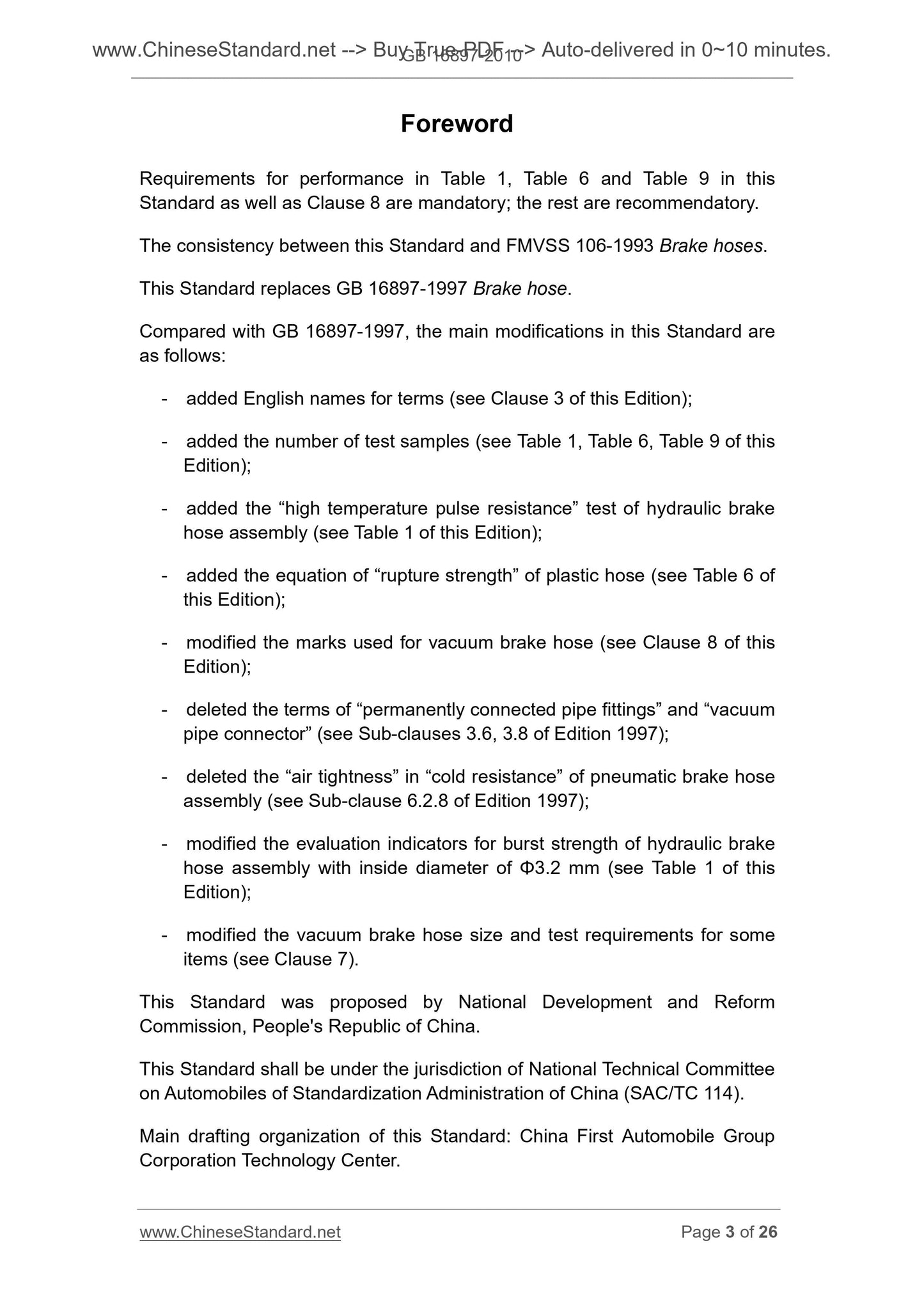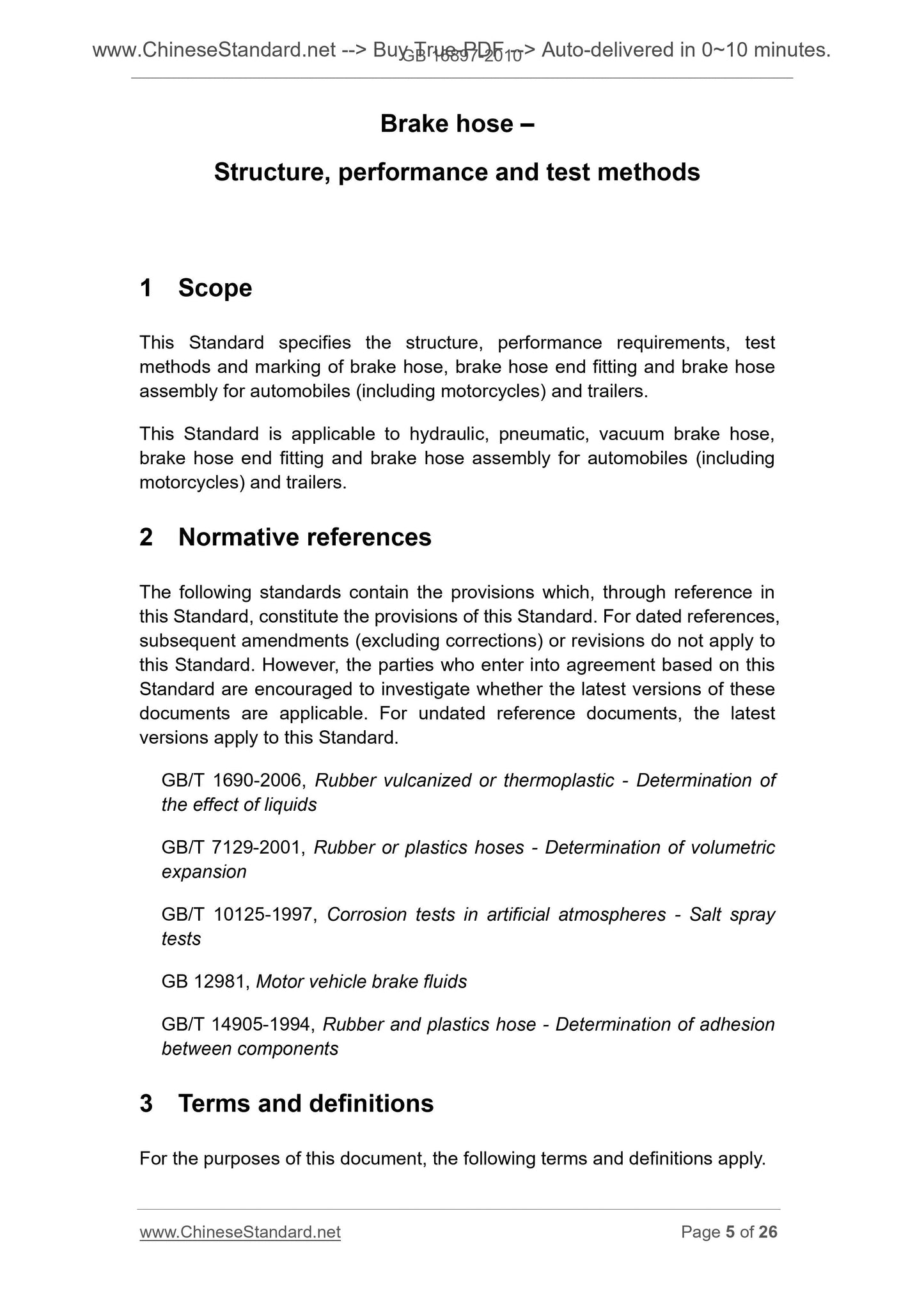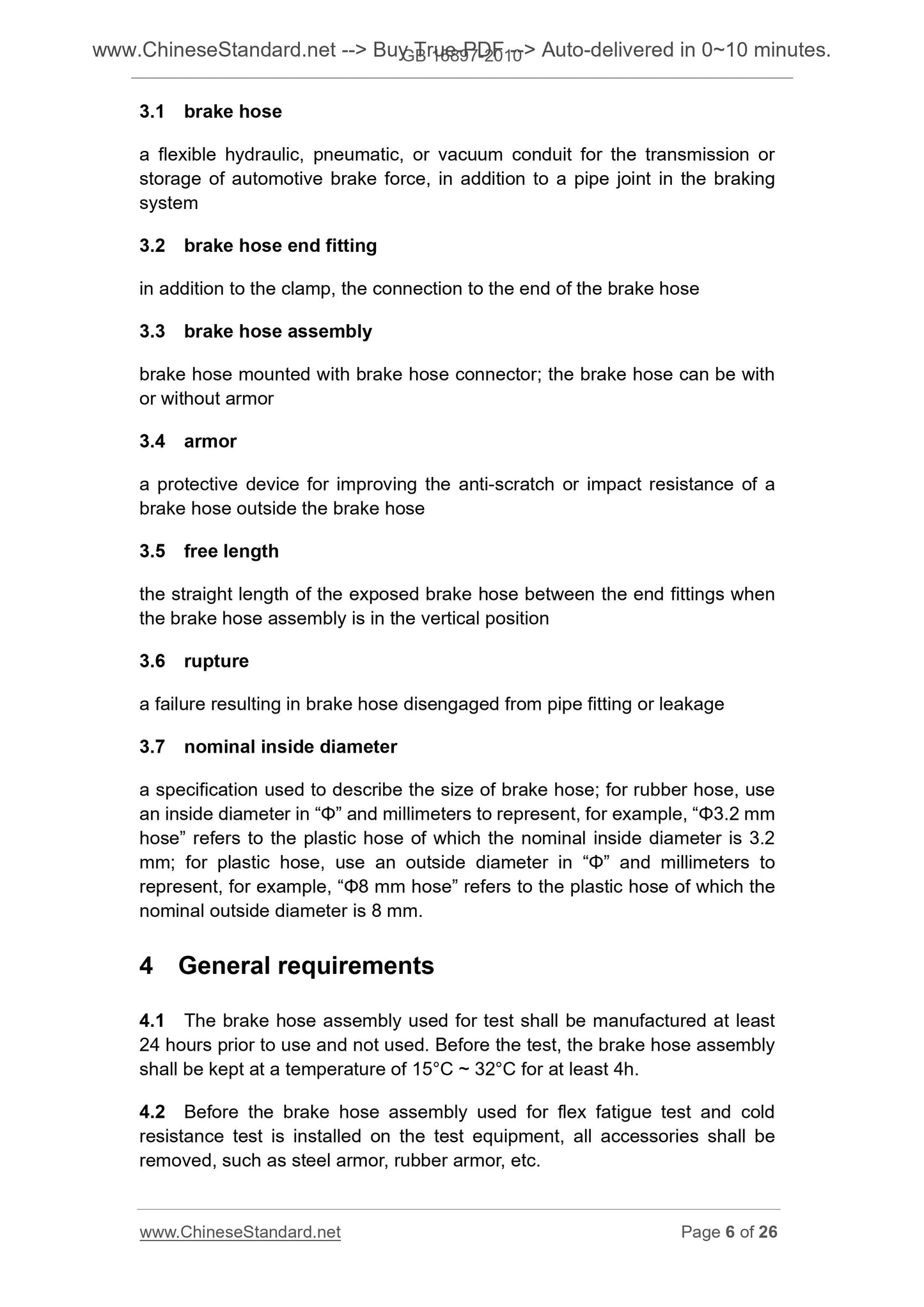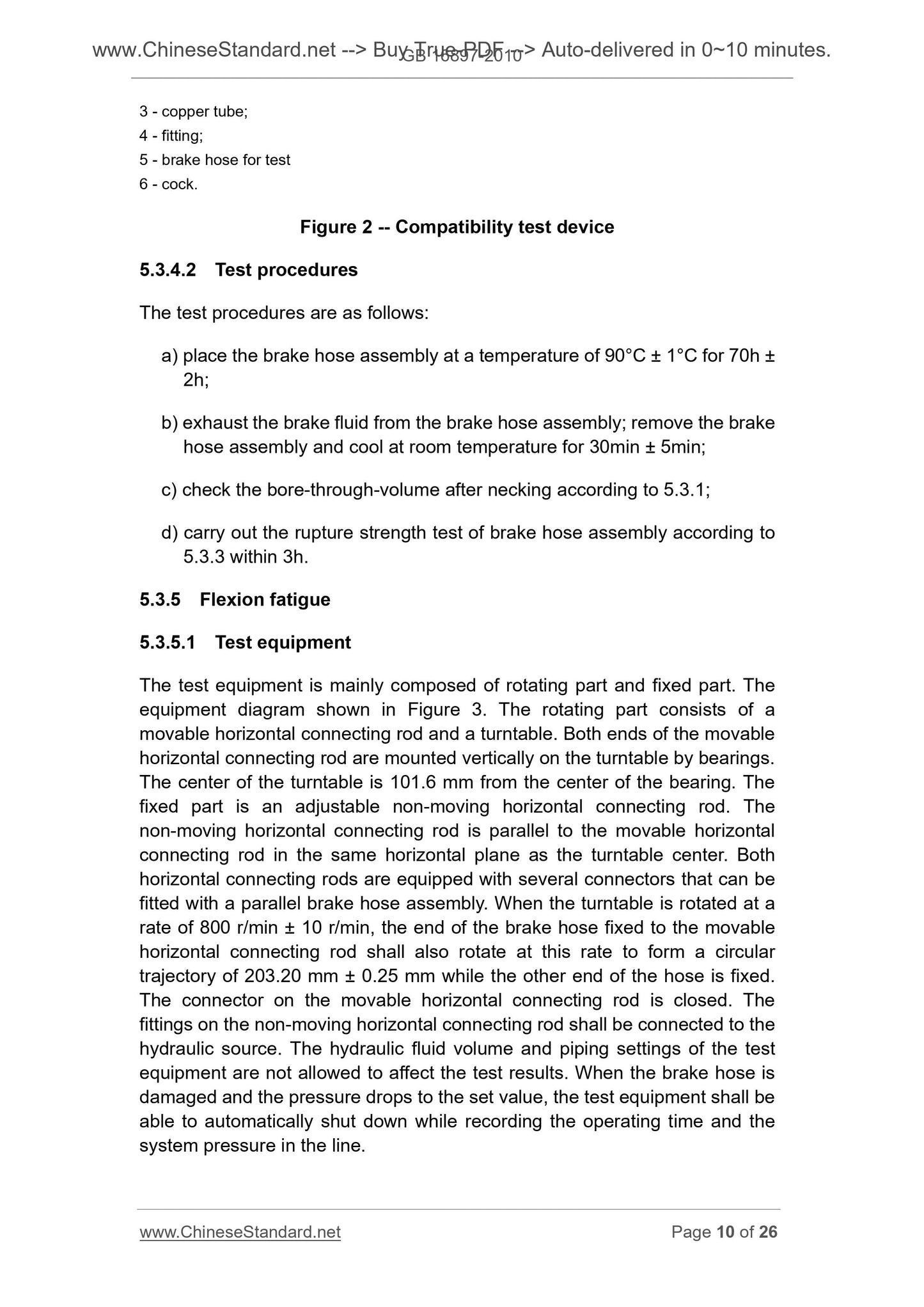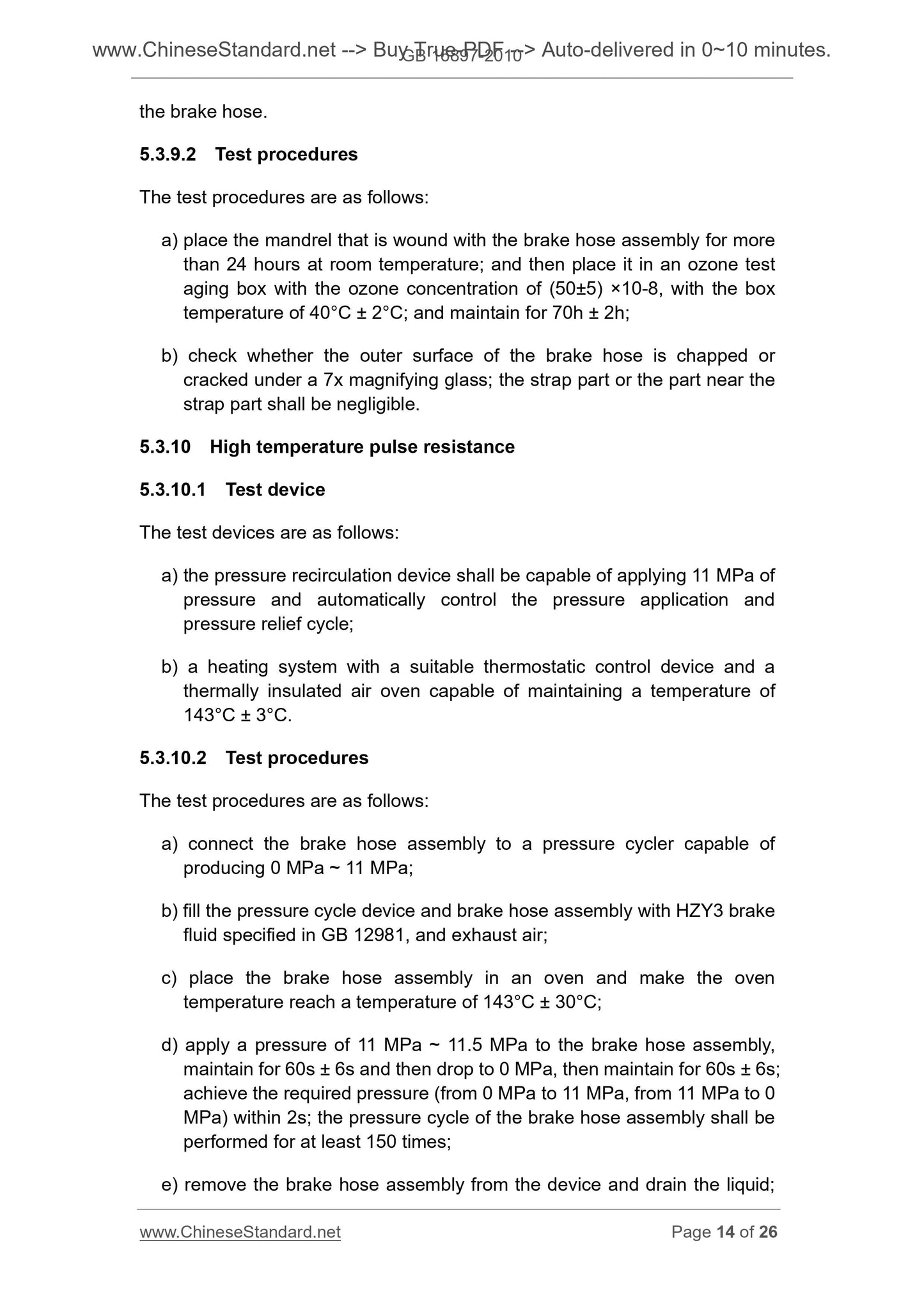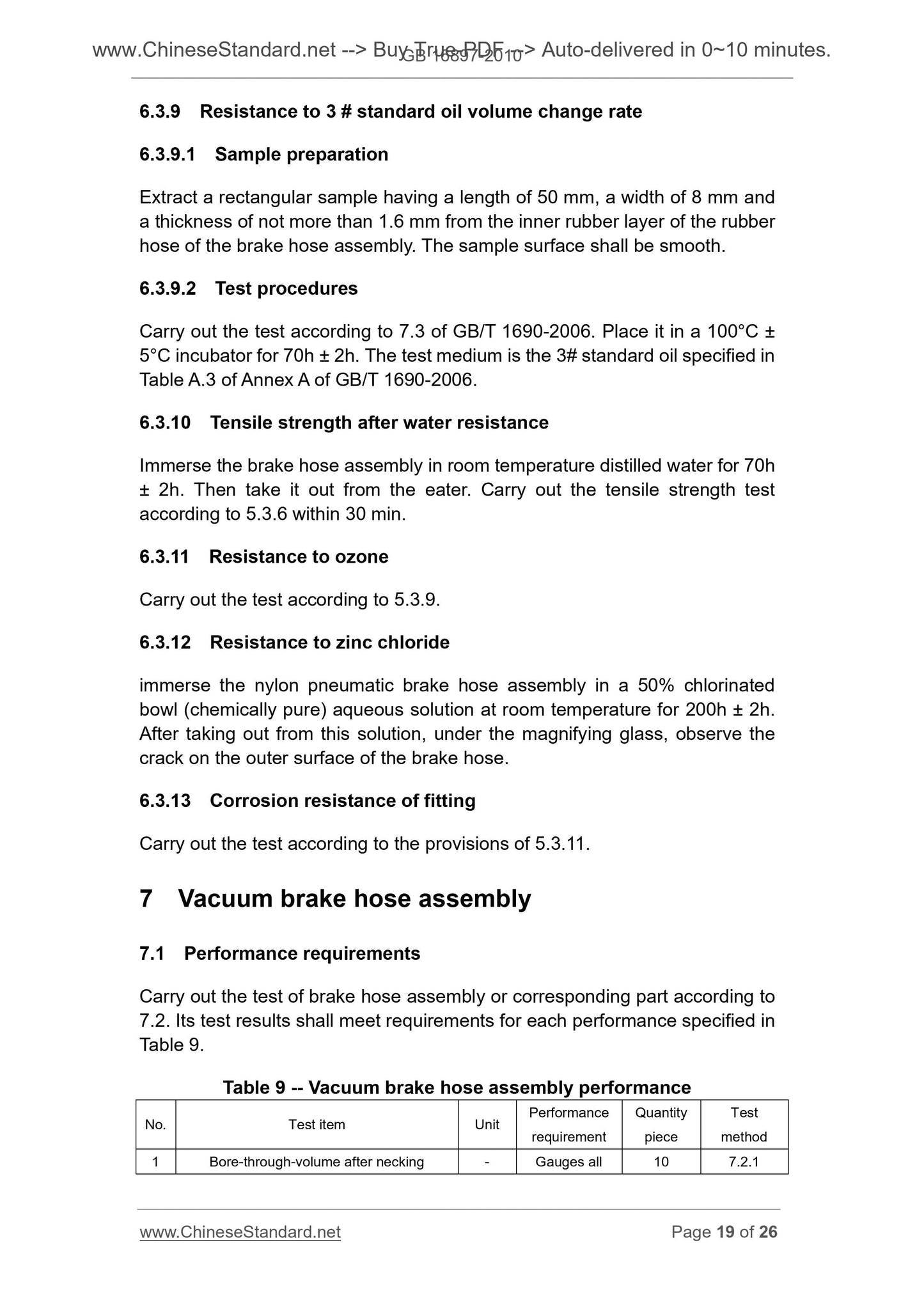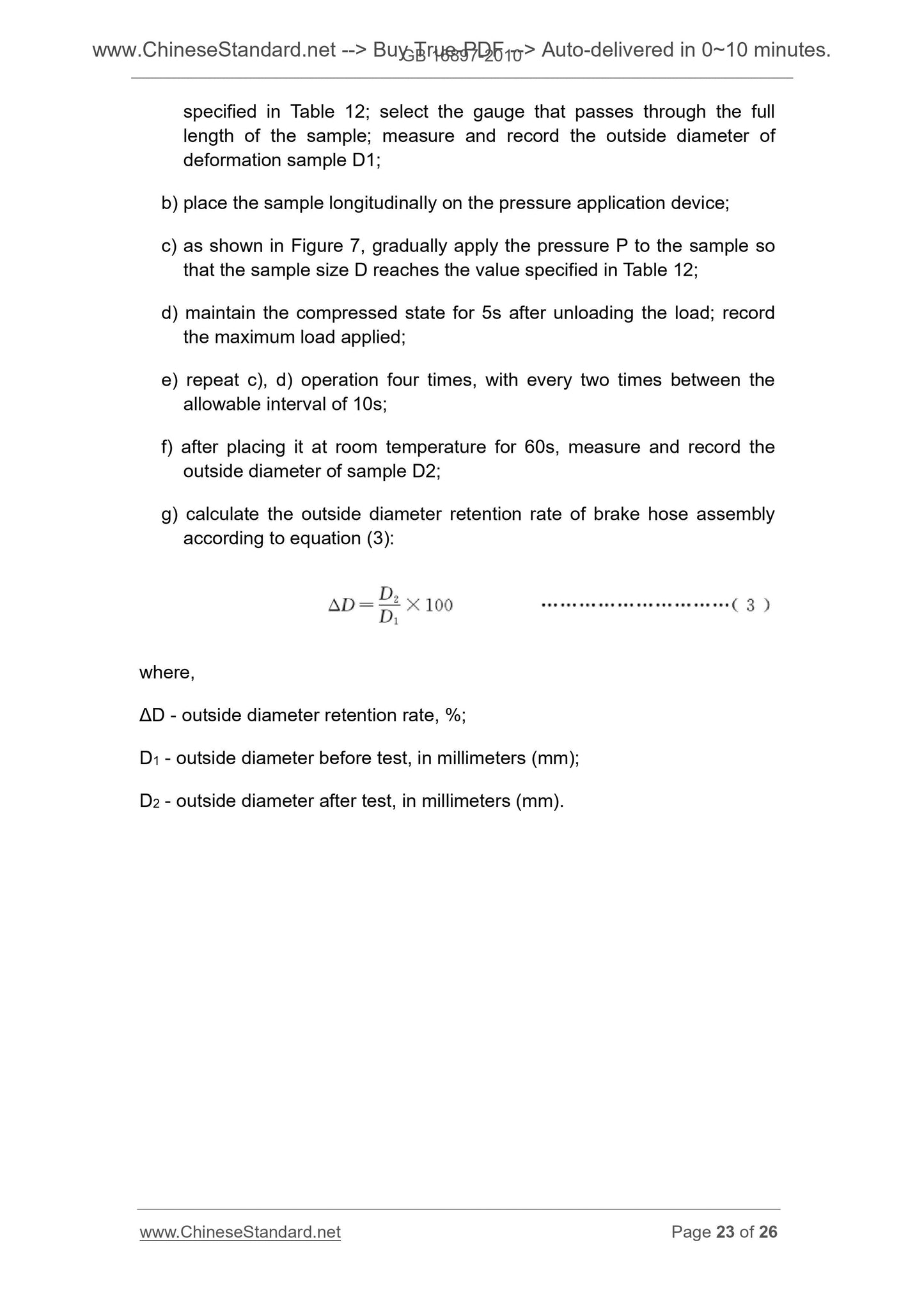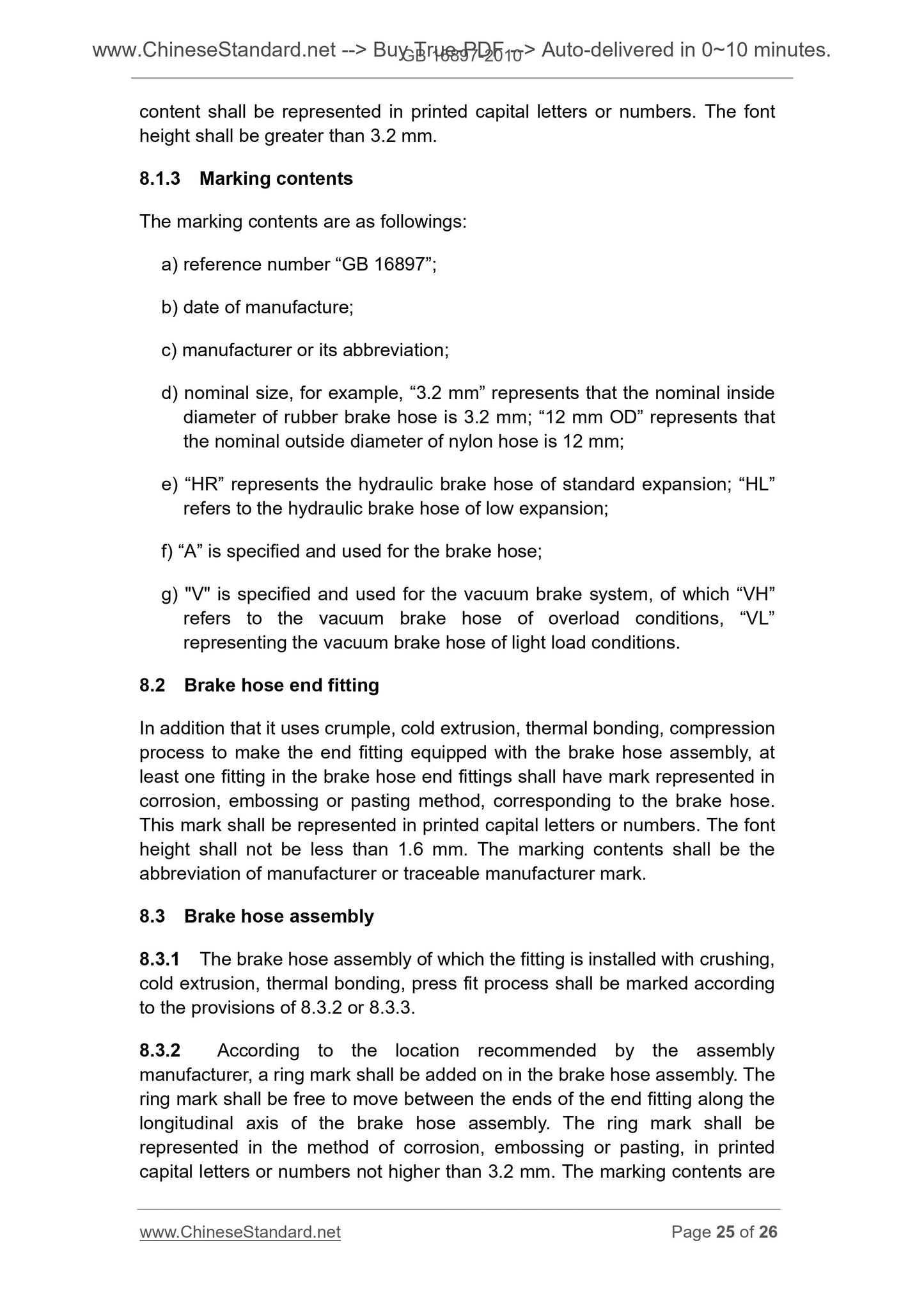1
/
of
10
PayPal, credit cards. Download editable-PDF & invoice in 1 second!
GB 16897-2010 English PDF (GB16897-2010)
GB 16897-2010 English PDF (GB16897-2010)
Regular price
$85.00 USD
Regular price
Sale price
$85.00 USD
Unit price
/
per
Shipping calculated at checkout.
Couldn't load pickup availability
Delivery: 3 seconds. Download true-PDF + Invoice.Newer version: (Replacing this standard) GB 16897-2022
Get QUOTATION in 1-minute: Click GB 16897-2010
Historical versions: GB 16897-2010
Preview True-PDF (Reload/Scroll if blank)
GB 16897-2010: Brake hose -- Structure, performance and test methods
GB 16897-2010
GB
NATIONAL STANDARD
OF THE PEOPLE’S REPUBLIC OF CHINA
ICS 43.040.40
T 24
Replacing GB 16897-1997
Brake hose –
Structure, performance and test methods
ISSUED ON. JANUARY 10, 2011
IMPLEMENTED ON. JULY 1, 2011
Issued by. General Administration of Quality Supervision, Inspection
and Quarantine;
Standardization Administration Committee.
3. No action is required - Full-copy of this standard will be automatically and
immediately delivered to your EMAIL address in 0~60 minutes.
Table of Contents
Foreword ... 3
1 Scope ... 5
2 Normative references ... 5
3 Terms and definitions ... 5
4 General requirements ... 6
5 Hydraulic brake hose assembly ... 7
6 Pneumatic brake hose assembly ... 15
7 Vacuum brake hose assembly ... 19
8 Marks ... 24
Foreword
Requirements for performance in Table 1, Table 6 and Table 9 in this
Standard as well as Clause 8 are mandatory; the rest are recommendatory.
The consistency between this Standard and FMVSS 106-1993 Brake hoses.
This Standard replaces GB 16897-1997 Brake hose.
Compared with GB 16897-1997, the main modifications in this Standard are
as follows.
- added English names for terms (see Clause 3 of this Edition);
- added the number of test samples (see Table 1, Table 6, Table 9 of this
Edition);
- added the “high temperature pulse resistance” test of hydraulic brake
hose assembly (see Table 1 of this Edition);
- added the equation of “rupture strength” of plastic hose (see Table 6 of
this Edition);
- modified the marks used for vacuum brake hose (see Clause 8 of this
Edition);
- deleted the terms of “permanently connected pipe fittings” and “vacuum
pipe connector” (see Sub-clauses 3.6, 3.8 of Edition 1997);
- deleted the “air tightness” in “cold resistance” of pneumatic brake hose
assembly (see Sub-clause 6.2.8 of Edition 1997);
- modified the evaluation indicators for burst strength of hydraulic brake
hose assembly with inside diameter of Φ3.2 mm (see Table 1 of this
Edition);
- modified the vacuum brake hose size and test requirements for some
items (see Clause 7).
This Standard was proposed by National Development and Reform
Commission, People's Republic of China.
This Standard shall be under the jurisdiction of National Technical Committee
on Automobiles of Standardization Administration of China (SAC/TC 114).
Main drafting organization of this Standard. China First Automobile Group
Corporation Technology Center.
Brake hose –
Structure, performance and test methods
1 Scope
This Standard specifies the structure, performance requirements, test
methods and marking of brake hose, brake hose end fitting and brake hose
assembly for automobiles (including motorcycles) and trailers.
This Standard is applicable to hydraulic, pneumatic, vacuum brake hose,
brake hose end fitting and brake hose assembly for automobiles (including
motorcycles) and trailers.
2 Normative references
The following standards contain the provisions which, through reference in
this Standard, constitute the provisions of this Standard. For dated references,
subsequent amendments (excluding corrections) or revisions do not apply to
this Standard. However, the parties who enter into agreement based on this
Standard are encouraged to investigate whether the latest versions of these
documents are applicable. For undated reference documents, the latest
versions apply to this Standard.
GB/T 1690-2006, Rubber vulcanized or thermoplastic - Determination of
the effect of liquids
GB/T 7129-2001, Rubber or plastics hoses - Determination of volumetric
expansion
GB/T 10125-1997, Corrosion tests in artificial atmospheres - Salt spray
tests
GB 12981, Motor vehicle brake fluids
GB/T 14905-1994, Rubber and plastics hose - Determination of adhesion
between components
3 Terms and definitions
For the purposes of this document, the following terms and definitions apply.
3.1 brake hose
a flexible hydraulic, pneumatic, or vacuum conduit for the transmission or
storage of automotive brake force, in addition to a pipe joint in the braking
system
3.2 brake hose end fitting
in addition to the clamp, the connection to the end of the brake hose
3.3 brake hose assembly
brake hose mounted with brake hose connector; the brake hose can be with
or without armor
3.4 armor
a protective device for improving the anti-scratch or impact resistance of a
brake hose outside the brake hose
3.5 free length
the straight length of the exposed brake hose between the end fittings when
the brake hose assembly is in the vertical position
3.6 rupture
a failure resulting in brake hose disengaged from pipe fitting or leakage
3.7 nominal inside diameter
a specification used to describe the size of brake hose; for rubber hose, use
an inside diameter in “Φ” and millimeters to represent, for example, “Φ3.2 mm
hose” refers to the plastic hose of which the nominal inside diameter is 3.2
mm; for plastic hose, use an outside diameter in “Φ” and millimeters to
represent, for example, “Φ8 mm hose” refers to the plastic hose of which the
nominal outside diameter is 8 mm.
4 General requirements
4.1 The brake hose assembly used for test shall be manufactured at least
24 hours prior to use and not used. Before the test, the brake hose assembly
shall be kept at a temperature of 15°C ~ 32°C for at least 4h.
4.2 Before the brake hose assembly used for flex fatigue test and cold
resistance test is installed on the test equipment, all accessories shall be
removed, such as steel armor, rubber armor, etc.
3 - copper tube;
4 - fitting;
5 - brake hose for test
6 - cock.
Figure 2 -- Compatibility test device
5.3.4.2 Test procedures
The test procedures are as follows.
a) place the brake hose assembly at a temperature of 90°C ± 1°C for 70h ±
2h;
b) exhaust the brake fluid from the brake hose assembly; remove the brake
hose assembly and cool at room temperature for 30min ± 5min;
c) check the bore-through-volume after necking according to 5.3.1;
d) carry out the rupture strength test of brake hose assembly according to
5.3.3 within 3h.
5.3.5 Flexion fatigue
5.3.5.1 Test equipment
The test equipment is mainly composed of rotating part and fixed part. The
equipment diagram shown in Figure 3. The rotating part consists of a
movable horizontal connecting rod and a turntable. Both ends of the movable
horizontal connecting rod are mounted vertically on the turntable by bearings.
The center of the turntable is 101.6 mm from the center of the bearing. The
fixed part is an adjustable non-moving horizontal connecting rod. The
non-moving horizontal connecting rod is parallel to the movable horizontal
connecting rod in the same horizontal plane as the turntable center. Both
horizontal connecting rods are equipped with several connectors that can be
fitted with a parallel brake hose assembly. When the turntable is rotated at a
rate of 800 r/min ± 10 r/min, the end of the brake hose fixed to the movable
horizontal connecting rod shall also rotate at this rate to form a circular
trajectory of 203.20 mm ± 0.25 mm while the other end of the hose is fixed.
The connector on the movable horizontal connecting rod is closed. The
fittings on the non-moving horizontal connecting rod shall be connected to the
hydraulic source. The hydraulic fluid volume and piping settings of the test
equipment are not allowed to ...
Get QUOTATION in 1-minute: Click GB 16897-2010
Historical versions: GB 16897-2010
Preview True-PDF (Reload/Scroll if blank)
GB 16897-2010: Brake hose -- Structure, performance and test methods
GB 16897-2010
GB
NATIONAL STANDARD
OF THE PEOPLE’S REPUBLIC OF CHINA
ICS 43.040.40
T 24
Replacing GB 16897-1997
Brake hose –
Structure, performance and test methods
ISSUED ON. JANUARY 10, 2011
IMPLEMENTED ON. JULY 1, 2011
Issued by. General Administration of Quality Supervision, Inspection
and Quarantine;
Standardization Administration Committee.
3. No action is required - Full-copy of this standard will be automatically and
immediately delivered to your EMAIL address in 0~60 minutes.
Table of Contents
Foreword ... 3
1 Scope ... 5
2 Normative references ... 5
3 Terms and definitions ... 5
4 General requirements ... 6
5 Hydraulic brake hose assembly ... 7
6 Pneumatic brake hose assembly ... 15
7 Vacuum brake hose assembly ... 19
8 Marks ... 24
Foreword
Requirements for performance in Table 1, Table 6 and Table 9 in this
Standard as well as Clause 8 are mandatory; the rest are recommendatory.
The consistency between this Standard and FMVSS 106-1993 Brake hoses.
This Standard replaces GB 16897-1997 Brake hose.
Compared with GB 16897-1997, the main modifications in this Standard are
as follows.
- added English names for terms (see Clause 3 of this Edition);
- added the number of test samples (see Table 1, Table 6, Table 9 of this
Edition);
- added the “high temperature pulse resistance” test of hydraulic brake
hose assembly (see Table 1 of this Edition);
- added the equation of “rupture strength” of plastic hose (see Table 6 of
this Edition);
- modified the marks used for vacuum brake hose (see Clause 8 of this
Edition);
- deleted the terms of “permanently connected pipe fittings” and “vacuum
pipe connector” (see Sub-clauses 3.6, 3.8 of Edition 1997);
- deleted the “air tightness” in “cold resistance” of pneumatic brake hose
assembly (see Sub-clause 6.2.8 of Edition 1997);
- modified the evaluation indicators for burst strength of hydraulic brake
hose assembly with inside diameter of Φ3.2 mm (see Table 1 of this
Edition);
- modified the vacuum brake hose size and test requirements for some
items (see Clause 7).
This Standard was proposed by National Development and Reform
Commission, People's Republic of China.
This Standard shall be under the jurisdiction of National Technical Committee
on Automobiles of Standardization Administration of China (SAC/TC 114).
Main drafting organization of this Standard. China First Automobile Group
Corporation Technology Center.
Brake hose –
Structure, performance and test methods
1 Scope
This Standard specifies the structure, performance requirements, test
methods and marking of brake hose, brake hose end fitting and brake hose
assembly for automobiles (including motorcycles) and trailers.
This Standard is applicable to hydraulic, pneumatic, vacuum brake hose,
brake hose end fitting and brake hose assembly for automobiles (including
motorcycles) and trailers.
2 Normative references
The following standards contain the provisions which, through reference in
this Standard, constitute the provisions of this Standard. For dated references,
subsequent amendments (excluding corrections) or revisions do not apply to
this Standard. However, the parties who enter into agreement based on this
Standard are encouraged to investigate whether the latest versions of these
documents are applicable. For undated reference documents, the latest
versions apply to this Standard.
GB/T 1690-2006, Rubber vulcanized or thermoplastic - Determination of
the effect of liquids
GB/T 7129-2001, Rubber or plastics hoses - Determination of volumetric
expansion
GB/T 10125-1997, Corrosion tests in artificial atmospheres - Salt spray
tests
GB 12981, Motor vehicle brake fluids
GB/T 14905-1994, Rubber and plastics hose - Determination of adhesion
between components
3 Terms and definitions
For the purposes of this document, the following terms and definitions apply.
3.1 brake hose
a flexible hydraulic, pneumatic, or vacuum conduit for the transmission or
storage of automotive brake force, in addition to a pipe joint in the braking
system
3.2 brake hose end fitting
in addition to the clamp, the connection to the end of the brake hose
3.3 brake hose assembly
brake hose mounted with brake hose connector; the brake hose can be with
or without armor
3.4 armor
a protective device for improving the anti-scratch or impact resistance of a
brake hose outside the brake hose
3.5 free length
the straight length of the exposed brake hose between the end fittings when
the brake hose assembly is in the vertical position
3.6 rupture
a failure resulting in brake hose disengaged from pipe fitting or leakage
3.7 nominal inside diameter
a specification used to describe the size of brake hose; for rubber hose, use
an inside diameter in “Φ” and millimeters to represent, for example, “Φ3.2 mm
hose” refers to the plastic hose of which the nominal inside diameter is 3.2
mm; for plastic hose, use an outside diameter in “Φ” and millimeters to
represent, for example, “Φ8 mm hose” refers to the plastic hose of which the
nominal outside diameter is 8 mm.
4 General requirements
4.1 The brake hose assembly used for test shall be manufactured at least
24 hours prior to use and not used. Before the test, the brake hose assembly
shall be kept at a temperature of 15°C ~ 32°C for at least 4h.
4.2 Before the brake hose assembly used for flex fatigue test and cold
resistance test is installed on the test equipment, all accessories shall be
removed, such as steel armor, rubber armor, etc.
3 - copper tube;
4 - fitting;
5 - brake hose for test
6 - cock.
Figure 2 -- Compatibility test device
5.3.4.2 Test procedures
The test procedures are as follows.
a) place the brake hose assembly at a temperature of 90°C ± 1°C for 70h ±
2h;
b) exhaust the brake fluid from the brake hose assembly; remove the brake
hose assembly and cool at room temperature for 30min ± 5min;
c) check the bore-through-volume after necking according to 5.3.1;
d) carry out the rupture strength test of brake hose assembly according to
5.3.3 within 3h.
5.3.5 Flexion fatigue
5.3.5.1 Test equipment
The test equipment is mainly composed of rotating part and fixed part. The
equipment diagram shown in Figure 3. The rotating part consists of a
movable horizontal connecting rod and a turntable. Both ends of the movable
horizontal connecting rod are mounted vertically on the turntable by bearings.
The center of the turntable is 101.6 mm from the center of the bearing. The
fixed part is an adjustable non-moving horizontal connecting rod. The
non-moving horizontal connecting rod is parallel to the movable horizontal
connecting rod in the same horizontal plane as the turntable center. Both
horizontal connecting rods are equipped with several connectors that can be
fitted with a parallel brake hose assembly. When the turntable is rotated at a
rate of 800 r/min ± 10 r/min, the end of the brake hose fixed to the movable
horizontal connecting rod shall also rotate at this rate to form a circular
trajectory of 203.20 mm ± 0.25 mm while the other end of the hose is fixed.
The connector on the movable horizontal connecting rod is closed. The
fittings on the non-moving horizontal connecting rod shall be connected to the
hydraulic source. The hydraulic fluid volume and piping settings of the test
equipment are not allowed to ...
Share
